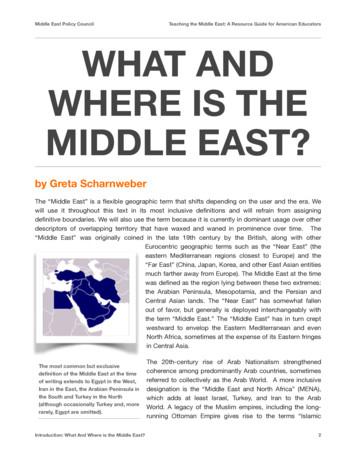Middle East History - Bhcourses
Middle EastHistory
Middle East Historical TimelineA Preliminary Look1.Pre-7th Century2.7th Century and the Advent of Islam3.7th Century—13th Century: Climax of Arab-Islamic Empiresa.Prophet Muhammadb.Rightly Guided Caliphsc.Umayyad Empired.Abbasid Empire4.15th Century-Early 20th Century: Ottoman Empire5.19th/20th Century to Mid-20th Century: European Colonial Rule6.1940s-1950s: National Independence7. Contemporary Periods(Arab Nationalism, Local Nationalism, Political Islam, Reform)
The Arab World
The Near East
AchaemenidEmpire, 559-330 BCSasanian Empire,224-651 AD
Pre-Islam ArabiaThe Myth of “the age of ignorance”
Islam and Islamic HistoryDiscussing Islam and Islamic history is amonumental task. What we will be doingtoday is to extract from these topics what willbe of use for the objectives of the course (wewill focus more on the historical rather thancultural and normative aspects of Islam)
Outline1-Historical origin of Islam2-Early Caliphate: Four Rightly-Guided Caliphs3-Divisions within Islam: Sunni, Shi a, Khawarij4-High Caliphate: Umayyads and Abbasids5-Ottoman Empire6-Islamic Belief and Practice: Sources ofauthority, 5 pillars, 4 articles of faith.
The Early YearsIslam is the last of monotheist religions revealed toMuhammad over a period of 22 years beginning in early7th century Arabia (610). Muhammad was orphaned at a young age. He worked as the business manager for a wealthywidow, Khadija, in the thriving commercial routesbetween Arabia and the fertile crescent. At 610 he started receiving divine revelations in theform of messages and verses that were later collectedand written in the Quran: 6000 verses orderedaccording to length (not chronologically).
Early ExpansionAfter a series of diplomatic efforts as well as battles,Muhammad was able to consolidate Islamic rule inArabia by unifying its diverse and warring tribes.Medina was the center of the Islamic community-statethat was created amidst the declining influence of theByzantine and Zoroastrian empires.
Rapid Islamic Conquests: A Mixed BlessingWithin a decade, Arab-Islamic forces asserted their ruleover what is known today as Iraq, Syria, Palestine,Iran, and Egypt. The Islamic current overran theirarmies and elites but preserved their bureaucracy,culture, and government. This type of conquest was amixed blessing: a source of tremendously rapidexpansion and a source of fragmentation during times ofreligious, political, or economic crises or conflict. Localpopulations found Islamic rule to be comparatively moretolerant than previous rule (Byzantine and Persian).Conquered populations were given three options:conversion, acceptance of Islamic dominance, battle.
The Caliphate 632-1258The history of the Caliphate is the history of Islam's politicaldevelopment. This is the source of much confusion with regard to thenature of Islam as a religion.We will be discussing 3 periods: Rightly Guided Caliphs,Umayyads, and Abbasids.Islam was politicized early on after the death of Muhammad, whichcreated the crisis of succession: Muhammad had not designated asuccessor neither did the Qur'an address this issue unequivocally.Initially, the Prophet's immediate companions agreed to select oracknowledge Abu-Bakr, an early convert, an advisor to Muhammad,and his father-in-law.
The Golden Age of Islam: The Rightly Guided Caliphs-Abu-Bakr and tribal rebellions (632-34)-Umar and the great period of expansion and conquest (634-644)-Uthman and tribal conflict between Mecca and Medina (644-656)-Ali and Islamic civil wars (656-661)Ali was supported all along by those who believed that he was the rightful successor to theProphet because of his blood ties (cousin and son-in-law). Ali faced two challenges:1-Aisha (daughter of Abu-Bakr, Prophet's widow)2-Mu awiyah: governor of Syria and Uthman's relativeHe Triumphed over Aisha and eventually lost to Mu awiyyah and was killed by the Kharijites.Ali lead an army to crush the rebellion of Mu awiyah who refused to step down as the governorof Syria and accept Ali's replacement. Mu awiyyah, fearing an eventual defeat, called for arbitrationwhich ended up inconclusive. Ali's acceptance of arbitration angered loyal supporters of Ali andlead to the formation of the Kharijites who eventually assassinated him in 661. Mu awiyah then laidsuccessful claim to the Caliphate, thereby ending Islam's Golden Age (normative period) andtransforming the caliphate into an absolute monarchy.
Organization and InstitutionsCaliphate: organization and administration of the Islamic stateIslam: basis of identity and ideologyAuthority of Caliph: derives from being successor toMuhammad: protector and defender of the faith, institutor ofShari a and he who spreads IslamModel for Governance: Muhammad's political practice.Classes-Arab Muslims-Converts-People of the book-Slaves
The Umayyad Empire: 661-750 Transformation of Caliphate to an absolute monarchy: hereditary vs. selection Centralization and militarization of the Islamic Empire Arabization: Reliance on Arab/Syrian warriors alienated non-Arab Muslims Moved capital to Damascus Expansion: North Africa, Spain, Portugal, Southern France, India. Created greater social stratification and enjoyed influx of new "foreign" ideas and practices Umayyad Caliphate denounced as dynastic rule and thus un-Islamic by many Muslims Excesses and infiltration led to the development of (mysticism and) the religious sciencesand the formulation and explication of Islamic law to safeguard beliefs and limit the powerof the Caliph Growth of opposition forces:1.Non-Arab Muslims as second class citizens,2.Kharijites and Shi is viewing Umayyads as usurpers,3.Arab Muslims in Mecca, Medina, and Iraq resenting Syrian privileges,4.Pious Muslims resenting luxurious lifestyles, social privileges, and unwarrantedinnovations.All above culminated in the downfall of the Umayyads at the hands of Abu al-Abbas whoinitiated the Abbasid era.
The Abbasid Empire: 750-1258 An era of strong centralized government, economic prosperity, andremarkable civilization. Abbasid rule borrowed heavily from Persian culture and was more inclusive Abbasid success was based less conquest and more on trade, commerce,industry, and agriculture Major contributions were made in philosophy, Algebra, geometry, science,medicine, literature, art, and architecture (some started during the Umayyadera). Abbasidsbecame the great patrons of an emerging religious class of Ulama(religious scholars) which further developed Islamic religious law: Shari a Abbasid rule was challenged by the Fatimid dynasty in Egypt and by thecrusades. Although the Abbasids more or less triumphed, their empire wasexhausted and fragmented. It fell apart in 1258 under the onslaught of themarching Mongols (yeeeee haaww!). The Ottoman Empire in the 15th century carried the mantle of Islam. (with theMoghuls and the Safavids Empires to the East).
The Ottoman Empire in World War I, 1914-1918
HusaynMcMahonAgreements,1915
Sykes-PicotAgreement,1916
The Balfour DeclarationForeign Office, November 2nd, 1917Dear Lord Rothschild,I have much pleasure in conveying to you, on behalf of HisMajesty’s Government, the following declaration of sympathywith Jewish Zionist aspirations which has been submitted to andapproved by, the Cabinet.“His Majesty’s Government view with favour theestablishment in Palestine of a national home for the Jewishpeople, and will use their best endeavours to facilitate theachievement of this object, it being clearly understood thatnothing shall be done which may prejudice the civil and religiousrights of existing non-Jewish communities in Palestine, or therights and political status enjoyed by Jews in any other country.”I should be grateful if you would bring this declaration tothe knowledge of the Zionist Federation.Yours sincerely,Arthur James Balfour
TheMandates,1920
Opposition to the Mandates, 1920-1945
Establishment of the Republic of Turkey
North Africa and West Asia, ca. 1920
The Interwar PeriodIndependence Struggles Interwar Period Marked by French and British Domination Arab Political Activity was devoted to achieving independence.Therefore:-other domestic considerations were put on the back-burner (e.g., welfare, land reform)-internal conflicts were glossed over (between notables, nationalists, and traditionalists) Elite Nationalism: Early Arab political leaders and colonization:-mostly land-owners and upper class professionals-maintaining their privileges required local bases of support & the blessing of Europeanpowers: this meant that compromises had to be made & resistance was moderated Popular Nationalism: 2nd Generation Leaders-a rising alternative leadership emerged: nationalist-populist, included most classes-the expansion of the state involved the mobilization/incorporation of working/middleclasses that were the seed for the overthrow of the “elite nationalist regimes.”-this is the leadership that in one way or another, continued to rule the arab world
The End of Colonialism in the Middle East The end of Colonialism-just as WWI weakened the grip of the Ottoman Empire, so did WWII with theEuropeans-Independence was formally granted, but imperial aspirations and dependencypersisted-Independent states and leaders struggled through a number of contradictions andchallenges (politically, socially, and economically) The Emerging Nation-States-marked by dependence-internal class disparities-disparities between rich and poor countries-uneven internal development-lack of institutionalization
4.! 15th Century-Early 20th Century: Ottoman Empire 5.! 19th/20th Century to Mid-20th Century: European Colonial Rule 6.! 1940s-1950s: National Independence 7. Contemporary Periods (Arab Nationalism, Loc
National Geographic’s current political map of the Middle East includes Pakistan, Afghanistan, and Central Asia, and partially cuts off Egypt and Turkey. Middle East Policy Council Teaching the Middle East:
2017 Middle East History and Theory Conference 1 Welcome to the 32nd Annual Middle East History and Theory Conference! The 2016 MEHAT Conference was made possible by generous financial support from the following University of Chicago sponsors: Center for Middle Eastern Studies Frank
1. globalism, regionalism and the middle east ayşegül sever 16 2. the challenges to middle eastern international society: a study in disorder onur erpul 32 3. united states foreign policy in the middle east after the cold war jonathan cristol 48 4. russian foreign policy in the middle east under putin: can bears walk in the desert?
janus et cie waterworks safavieh l e xin g t on a venu e t h ir d a venu e s e c on d a v e nu e east 55th street east 5th street east 5th street east 5th street east 59th street east th street east d street east d street east s t street tutenkian artisan carpets the catholic center of an a sa tvern
Stemmers Run Middle White Oak School Windsor Mill Middle Woodlawn Middle Caroline Col Richardson Middle Carroll Crossroads Middle Cecil Elkton Middle Charles General Smallwood Middle R.D. Stethem Ed Center Dorchester All schools are enrolled in CEP! Harford Center for Ed Opportunity Alt
031901043 faulk middle: sw 96.54%: 031901044 stell middle: sw 95.70%: 031901045 oliveira middle: sw 94.80%: 031901046 perkins middle: sw 97.41%: 031901047 vela middle: . a p solis middle sw 88.35% 108902046; veteransmiddle sw 92.36% 108902047; dora m sauceda middle sw 97.34% 108902048; w a todd middle sw 93.21% 108902102;
cultures in the Middle East. There are several religions in the Middle East. Many Muslim beliefs are similar to ours. The status of Middle Eastern women is complex. Middle Eastern attitudes toward the U.S. are complicated.
List of Plates Plate 1 Tea break! 4 Plate 2 Outline of robbed out wall visible in Trench 2c. Taken from the N. 8 Plate 3 W facing fireplace [2055], during excavation. Taken from the SW. 9 Plate 4 General view of fire place and rake out area following excavation, Trench 2c. Taken from the SW. 9 Plate 5 Stake [2091], set into natural sand (2072). Taken from the N 10























